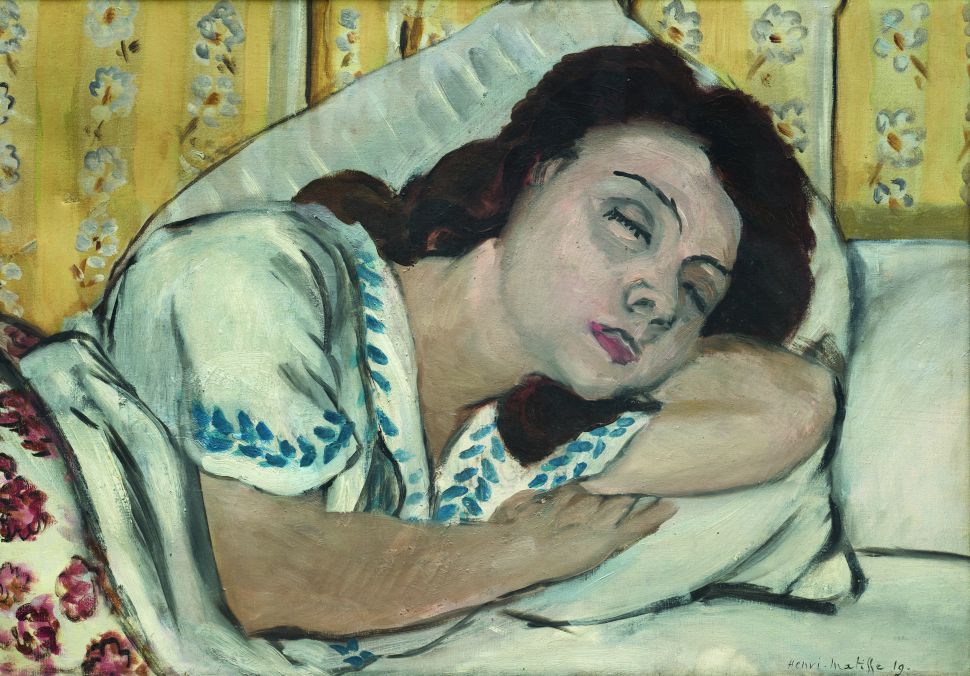Henri Matisse painted many subjects throughout his lifetime, but one he returned to again and again was his daughter, Marguerite. “Matisse and Marguerite Through Her Father’s Eyes” at the Musée d’Art Moderne in Paris brings together more than 100 works (paintings along with drawings, prints, sculptures and ceramics) that capture the essence of Marguerite Duthuit-Matisse. The museum calls her “little known,” but, as exhibition co-curator Charlotte Barat-Mabille tells Observer, “Matisse depicted his daughter over a hundred times, and her portraits were exhibited in many major international exhibitions.”
Perhaps little known, but often shown? “The fact remains that, until now, the public did not know much about her,” Barat-Mabille clarifies. “One reason might be that Marguerite herself was quite a private or reserved person—for instance, she only gave one interview in her lifetime, in 1970. And when the journalist began by asking whether she inspired her father, she dodged the question and spoke about his other models.”
This reluctance to speak about personal matters was very much shared among the Matisse family, but it’s known that Marguerite served as her father’s muse and, later, his manager. She was, from childhood into her young adulthood, his most constant model—the only person to appear in his work across several decades. “Matisse and Marguerite Through Her Father’s Eyes” traces the bond between father and daughter and their mutual trust and respect. It also shines a light on Marguerite’s influence on Henri’s career and artistic oeuvre.
SEE ALSO: The Goldfinch and the Dutch Golden Age – Remembering Carel Fabritius
Marguerite, the eldest of Matisse’s three children, was born in 1894—the result of a brief relationship between the artist, then a young painting student, and his model Caroline Joblaud. She was legally recognized by her father and grew up alongside her half-brothers, Jean Matisse (1899-1976) and Pierre Matisse (1900-1989), the sons of Henri and his wife Amélie Matisse.
While by all accounts the family was a happy one, Marguerite’s younger years were marked by pain and illness. She didn’t attend normal school due to poor health and became a “studio child,” watching her father as he worked. At age seven, her first tracheotomy left a scar on her neck that she often concealed with a black ribbon: a distinctive feature in many of her portraits.
“In the painting that opens the exhibition, which might have been created right after her painful tracheotomy, Marguerite’s face is covered in white. She appears very pale and quite frail—but at the same time, she has these very large and dark eyes looking at us with such intensity,” says Barat-Mabille. “It is a very poignant painting, which says it all: she was fragile, but also incredibly strong.”
Many years later, in 1923, Marguerite married the writer Georges Duthuit and no longer appeared as a subject in her father’s paintings. However, she continued to work for him, fielding requests from collectors, historians and art dealers. She would eventually direct the assembly of the catalogue raisonné of his work (a task she never saw completed as it was finished a year after her death in 1982). She was an active part of the French Resistance during the Second World War and was arrested and tortured by the Gestapo but managed to escape as she was being transported to a concentration camp. Henri painted her in 1945, showing her suffering alongside her only child, Claude.
Some of the rare works on view in this chronologically organized exhibition include Marguerite with a Black Cat, completed in 1910, in which she is posed in a blue dress against a green background. It’s a painting that Henri never wanted to sell. “Like many artists, Matisse was well aware of the importance of certain paintings; he knew that it was one of the most beautiful portraits he had ever created and one of the most radical as well,” co-curator Isabelle Monod-Fontaine tells Observer.
Matisse showed the painting in several exhibitions, including at the original Armory Show (the “International Exhibition of Modern Art”) in 1913. “But for him, there was certainly the sentimental value attached to this magnificent image, created after his daughter,” Monod-Fontaine adds. But other works featuring Marguerite were sold, like Marguerite Reading, and of course, Henri Matisse had other models. Another rare work on view here is Chapeau de Roses, a portrait of Amélie Matisse from 1914.
Marguerite endormie, painted in Étretat in 1920 and now part of the collection of the Norton Museum of Art “has not been shown in France for decades, if ever,” Monod-Fontaine says. “Same for the three paintings lent by the Baltimore Museum of Art. And also Marguerite en manteau écossais, lent by a private collection.” For fans of the artist, the exhibition may represent a once-in-a-lifetime chance to see certain pieces usually hidden away in American, Swiss and Japanese collections. “Most of the works on paper coming from private collectors are also being shown in France for the very first time.”
“Matisse and Marguerite Through Her Father’s Eyes” is at the Musée d’Art Moderne in Paris through August 24, 2025.

